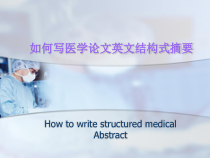 PPT
PPT
【文档说明】如何写医学论文英文结构式摘要课件.ppt,共(63)页,368.512 KB,由小橙橙上传
转载请保留链接:https://www.ichengzhen.cn/view-253501.html
以下为本文档部分文字说明:
如何写医学论文英文结构式摘要HowtowritestructuredmedicalAbstractIntroduction摘要,亦称文摘(Abstract或Summary),一般置于论文、科研报告或文摘
综述的正文之前,是对整个论文主要内容的概括和总结。它具有独立性与自含性。独立性-----指读者无需依赖原文就能准确把握摘要所表达的含义。摘要是一种独立的文献类型。自含性-----指摘要内的名词术语、缩略语、符号、代号符合规范,具有自
明性。摘要本身属于一篇完整的短文。摘要的种类非结构式摘要(Non-structuredAbstract)结构式摘要(StructuredAbstract)摘要的内容(1)指示性摘要(IndicativeAbstract)指示性摘要,亦称通报性文摘,一般只提示论文的要点,不涉及其方法、材
料、数据、结果等内容,有的甚至只用1-2个句子。医学文选综述的摘要多为提示性的。这种摘要为非结构式摘要,句中谓语动词常用一般现在时或现在完成时。例:论原发性胃肠道淋巴瘤◼本文综述了治疗原发于胃肠道淋巴瘤的主要经验,并就该病的临床、病理及治疗等问题进行了讨论。◼PrimaryL
ymphomasoftheGastrointestinalTract◼AninstitutionalexperiencewithprimarygastrointestinalLymphoma(PGL)isrevi
ewed.Theclinical,pathologic,andtherapeuticaspectsofPGLarediscussed.(2)报道性摘要(InformativeAbstract)◼报道性摘要,亦称资料性摘要,内容比较具体,一般要列举关键数据,大多医学论文的摘要为报道
性摘要。一般包括下述内容:◼a.简介(BriefIntroduction):介绍研究背景(Background)、目的(Objective/Purpose)或解题性说明(Explanation);◼b.研究的过程与结果(Proc
edureandResultoftheResearch);◼c.结论(Conclusion);◼d.对未来的展望(FutureProspects);MalignantHypertensionandCigaretteSmokingThesmokingha
bitof48patientswithmalignanthypertensionwascomparedwiththoseof92consecutivepatientswithnon-malignanthypertension.Thirty-threeofthepatient
swithmalignantand34ofthepatientswithnon-malignanthypertensionweresmokerswhenfirstdiagnosed.Thisdifferencewassignificant
,andremainedsowhenonlymenorblackandwhitepatientswereconsideredseparately.Resultssuggestthatmalignanthypertensionisyetanotherdisea
serelatedtocigarettesmoking.将48例高血压患者与92例非恶性高血压患者作了吸烟习惯的对比研究。初诊时就已吸烟的恶性高血压患者有33例,非恶性患者34例,两者之间有明显差异。即使对男性患者进行比较,
或将白人与黑人分别进行比较,这种差异也仍然显著。本研究表明:恶性高血压是一种与吸烟有关的疾病。医学论文摘要的格式目前主要采用结构式摘要(structuredabstract),它是由加拿大McMaster大学临床流行病学和生物统计学教授Haynes博士于
1990年4月首先提出的。而几乎在同年,美国《内科学纪事》(AnnalsofInternalMedicine'AnnInternMed)在国际上率先应用结构式摘要,随之,世界各国的医学期刊都采用了结构式摘要。这些结构式摘要有8
段式、7段式、6段式、5段式、4段式及3段式等,内容主要包括研究目的、研究设计、研究单位、研究对象或病人、处理方法、检测方法、结果及结论共8项。而在实际应用中,8段式结构式摘要逐渐简化为4段式。我国大多数医学期刊都采用了4段式结构式摘要,即目的、方法、结果和结论。1)目的(object
ive):简要说明研究的目的,表明研究的范围、内容和重要性,常常涵盖文章的标题内容。(2)方法(methods):简要说明研究课题的设计思路,使用何种材料和方法,如何对照分组,如何处理数据等。(3)结果(results):简要介绍研究的主要结果和数据,有何新发现,说明
其价值及局限。此外,还要给出结果的置信值,统计学显著性检验的确切值。(4)结论(conclusion):简要对以上的研究结果进行分析或讨论,并进行总结,给出符合科学规律的结论。Abstract本文主要介绍医学论文英文结构式摘
要的四个部分:目的、方法、结果和结论,并探讨其写作内容与方法、时态与语态和常用句型。◼为了便于讨论的展开,我们先看摘自一篇被SCI收录的医学论文英文结构式摘要。例一:◼Objective:Toinvestigatetherelationshipbetweenthemas
tcelldensity(MCD)andthecontextofclinicopathologicalparametersandexpressionofp185,estrogenreceptor(ER),andprolif
eratingcellnuclearantigen(PCNA)ingastriccarcinoma.◼Methods:Mastcell,p185,ER,andPCNAweredetectedbyusingimmunohistochemicalS-Plabelingmethod.Mast
cellwascountedintissueofgastriccarcinomaandregionallymphnodesrespectively,andinvolvedlymphnodes(ILN)wereexaminedasusual.◼R
esults:MCDwassignificantlyrelatedtobothageanddepthofpenetration(x2=4.688,P<0.05forageandx2=9.350,P<0.
01fordepthofpenetration)betweenMCD>21/0.03mm2andMCD≤21/0.03mm2in100patients.MCDin1-6ILNgrouppatientswassignificantlyhigherthanthat
in7-15ILNor>15ILNgrouppatients(u=6.881,8.055,P<0.01).Thereweresignificantdifferencesinter-groupinpositiveexpressionrateofp185,ERandPCNAbetwee
nMCD>21/0.03mm2andMCD≤21/0.03mm3in100patients.◼Conclusion:Mastcellmayhaveaneffectoninhibitinginvasivegrow
thoftumor,especiallyintheagedpatients.Thenumberofmastcells,incertaindegree,maypredicateassessmentofp
rognosis.MCDwasrelatedtotheexpressionofp185,ER,andPCNAingastriccarcinoma.Itsuggeststhatmastcellaccumulationmayinhibittheproliferationandt
hedisseminationofgastriccarcinoma.◼这种格式是国际医学期刊编辑委员会制定的《生物医学期刊投稿统一要求》(温哥华格式,1997年第五版)所规定的四层次摘要,包括:目的、方法、结果和结论,并在文字上要求结构式摘要的英文不超过250词(我国编辑标准要求中文摘
要为200-300字)。不同期刊对摘要的长度有不同要求,例如:JAMA(美国医学协会杂志)规定摘要不得超过135词;AmericanJournalofMedicalSciences(美国医学杂志)规定不宜超过200词。1结构式摘要的目的部分◼1.1目的部分的
写作内容与方法◼摘要中目的部分是说明论文要解决的问题。目的的英文称Objective,Purpose或Aim,一般用单数形式。单表目的主要用动词不定式短语。如例一中Objective部分只用不定式短语表达。1.2目的部分的常用句型◼研究/探讨:st
udy/explore/examine/investigate;确定:decide/determine/characterize;评价:evaluate/assess/judge/validate/a
ppraise/estimate/calculate/appreciate;证实:testify/verify/prove/test/support/confirm;阐明/弄清:indicate/show/demonst
rate/document/illustrate/explain/findout/elucidate;介绍/报道:report/present/describe;寻找:seek/find/lookfor/searchfor;建立:develop/establish/setout;比较/对比:com
pare/correlate/associate/contrast…with;区别/识别:identify/differentiate/discriminate2结构式摘要的方法部分◼2.1方法部分的写作内容与方法◼论文的材料与
方法(MaterialsandMethods)、对象和方法(Patients/Participants/SubjectsandMethods)等在结构式摘要中简称为方法,英文称Methods,常用复数形式。方法部分应具体而真实地陈述研究设计、研究对象、处理与测定方法
和统计学分析。方法部分一般用过去时,多用被动语态。有时,叙述方法也可用过去完成时,说明研究前或研究中某一时间之前发生的情况。如例一中Methods部分,句中动词使用过去时被动态。2.2方法部分的常用句型◼1)研究对象的选择
、分组及标准:inclusion/entrycriteriaconsistedof/were(入选的标准是);selectionwasbasedon/wereselectedbasedon;wereselectedrandomlyfrom;themajorcriteriaforinclusio
ninthestudywere;wereconsideredineligiblefor;wereexcludedfromthestudy/participation/enrollmentwererandomizedinto/wererand
omlyallocatedto/weredividedrandomlyinto;weredivided/grouped/stratified/allocated/classify-ed/assignedinto/to(被分成)◼2)材料来源:wa
sprovidedby;waspurchasedby(购自);wasobtainedfrom;usingOsteoAnalyzers(Simens-Osteorn,Wahiwas,Hawaii)用骨分析器(由夏威夷西门子奥斯汀公司生产)◼3)实验动物处置:
wasbred/fedin;wasfasted/starved12hoursbeforeoperation;…whiterabbitsweighingbetween…and…wereused;waskilled
bydecapitation/cervicaldislocation/exsanguinations(被断头/放血/处死);wasanesthetizedwith◼4)借鉴他人实验方法:wasisolatedbytheprocedureof;wasprep
aredaccordingtothemethodsdescribedby;wascarriedoutaspreviouslydescribed;wasseparatedbythetechniquepreviously;wasdonewithamodifiedmethodof;wasde
termined/measuredby/with◼5)实验标本制备:samplesof…wereobtained/takenfrom;wasfixedwith/in;wasstainedwith(用…染色);wasembeddedin/with(被包埋在);wasdehydr
atedby/in(用…脱水);wassectionedatathicknessof(切成…薄片);wasslicedinto1mmsections(切成1mm厚薄);wascutona…ultramicrotomeinto(在…超薄切片机上切成);wasdil
utedto(被稀释到)6)年龄与性别:在某一年龄,如一个45岁病人:a45-year-oldpatient/apatientaged45(years)/apatientat45yearsofage/apatientatthea
geof45years(old);在某一年龄以上或以下:apatient/morethantheageof45years;olderthan45years;morethan45yearsofage;patientsag
ed45±3years;45yearsofage/orolder;apatientunder/before/below/lessthan/aftertheageof45(years);45yearsof
ageandunder/orless;lessthan/youngerthan45years;在某一年龄范围及平均年龄:patientsrangeinagefrom45to50/haveanagerangeof45to50/withame
an(average)ageof45±3years;性别比例:male-to-femaleratio/withfemale-maleratioof2:1/ratsofbothsexes/mixed-breddogsratioofeithersex◼7)诊断与治疗:wasdia
gnosedas/by/with/accordingto/onthebasisof;wasmisdiagnosedas/wasmistakenas(for);wassuspectedas/ofhaving…/tobe;treatedfor;was
thetreatmentofthefirstchoice;wasreferred/transferredto3.结构式摘要的结果部分◼3.1结果部分的写作内容与方法◼结果在摘要中英文称Results,常用复数形式。该部分主要表述研究所获得客观的、与研究结论有关的重要结果。如有可能,应提供具体
数据和统计学资料。由于研究实验结果是回顾性陈述,因此,常用一般过去时,使用被动语态较为普遍。如例一中Results部分,句中动词使用过去时。3.2结果部分的常用句型◼1)结果表明:theresultsshowed/suggested/indicated/revealed/documented/
demonstratedthat…;Wefoundthat;was/werefoundto/that…◼2)与…有关:wasinrelationto;wascorrelated/associated/connectedwith
;therewasarelationship/correlation/associationbetweenAandB;wasfoundtobecorrelated/associatedwith…;therewasarelation/correl
ationofAandB◼etimes;twoorthreetimes/2or3times;twiceasmuchas;increased(decreased)by3fold/times;Awas3fold/timesas…asB(A是B的3倍);wasdec
reased/reduced/dropped/◼lowered/declinedby/to;withanoverallincreaseof(总的增加);withamean/averageincreaseof(平均增加);theratioofAtoB◼4)比较与对比:
wasequalto;…ofAwassimilar/analogoustothat/thoseofB(A…与B…相似)wascomparedto/with;wasconsistent/comparablewith;inc
ontrast/onthecontrary/whereas◼5)统计学上的区别:Therewasvery/highlysignificantdifferencein…betweenAandB;nosignificant/insignificant/nonsignificantwas◼fo
und/observed/notedin…betweenAandB4.结构式摘要的结论部分◼4.1结论部分的写作内容与方法◼结论部分是作者对研究发现或实验结果得出的主要结论,包括理论意义、直接的(可能的)临床意义或应用价值。结论的英文称Conclusion(s)。叙述结论
时,如果作者认为本研究结论具有普遍意义,用一般现在时;如果作者认为自己的结论仅仅是一种可能性或只表示当时的研究结果和研究范围,则用一般过去时。例如:◼Conclusion:Themajorityoftheresults
demonstratetheeffectivenessofTiclopidineasanantiaggregation.4.2结论部分的常用句型◼1)用于引出研究结果的词语也可用于引出研究的结论,但在时态的使用
上不同,前者用一般过去时,后者用一般现在时。例如:data/resultsshow/suggest/demonstrate/confirm/indicate(数据(结果)/说明/证实/提示/揭示…)◼2)在结论部分,作
者客观、委婉地陈述自己的看法和建议,推测或评论某种情况,很难作出非常肯定或否定的观点时,除了用may/might/can/could/probably/presumably/should等词语表达外,还可用以下句型:(not)appearto/seemto/Itislikel
y(unlikely)that/thereis(no)evidencethat/mayprove(tobe)◼3)具有…意义:beofgreat/some/little/noclinicalsignificancein…/to…;be
ofgreat/little/nolimiteduse/application/valuein…/to…◼4)支持或反对某种观点、理论、假说等:support/failtosupporttheidea(theory/proposa
l/hypothesis/findingsofpreviousstudies)that;supply/offerabasisfor;poseachallengeto;areconsistent/inaccord/withthetheory/proposal/hy
pothesis/previousstudiesthat;besimilartothatreported/described/documentedby(与…报道/描述/证明相似);becontrastedwith/differentfrom。◼5)分析(可能的)原因:maybecausedb
y;mayleadto/resultin/accountfor/bethecause/resultof;beresponsiblefor;bedueto;contributeto;giveriseto◼6)前瞻性说明:remainstobeproved;needstob
efurtherinvestigated/examined/studied/assessed/evaluated;remainstobeuncertain◼综上所述,结构式摘要层次清楚,简明扼要,信息丰富,便于写作,文献检索和信息交流摘要写作与翻
译中应注意的问题文章标题文章标题具备信息功能(提供文章的主要内容)、祈使功能(吸引读者阅读和购买)、美感功能(简单明了、新颖、醒目)和检索功能(方便读者和科技工作者检索、查阅及引用)。医学论文的标题还有它自己的特点,即有较多的专业术
语和较长的字数。对于它们的翻译,要忠实于原文,一般都采用直译方法,并且要注意各成分之间的关系。请看下例“针刺对冠心病心绞痛患者左心功能状态的影响”Theacupunctureeffectonleftventricularfunc
tioninpatientswithcoronaryheartdiseaseandanginapectorisNote:层层修饰关系在译文中均以介词连接,译文简洁而明晰。语态在英语中,被动语态的使用远不及主动语态广泛。然而,在翻
译医学论文摘要时,却常常采用第三人称的被动语态。这是因为医学研究着重于客观事物和过程的描述,使得整项活动更显出科学性。同时,被动语态的句子在结构上有较大的调节余地,有利于采用必要的修辞手段,扩大句子的信息量,从而突出重要的概念、问题、事实、结论等内容请看下例“采用West
ernblotting技术检测37例食管鳞状细胞癌组织、癌旁组织、区域淋巴结和相应正常食管组织中P73蛋白的表达,并探讨与食管临床病理特征的关系。”TheexpressionofP73proteinwasdetect
edbyWesternblottingin37casesofesophagealtumortissues,para-cancertissues,regionallymphnodesandmatchedesophagealnor
maltissuesandtheirrelationtoclinicalpathologiccharacteristicsofesophagealcancerwasexplored.时态时态是大多数作者遇到的一大难题,他们不知何时该用何种时态。有时全文从头到尾只用一种时
态,或几种时态杂乱交错,给人不知所云的感觉。医学论文摘要中所采用的时态主要是一般现在时和一般过去时,偶尔也会出现完成时。而它们的功能也很明确,即,一般现在时(偶尔有现在完成时)使用于摘要的目的与结论当中。对于摘要的目的,现在常常省略主语,只用不定式
短语进行表达。请看下例“106例宫颈癌均行广泛性子宫切除和盆腔淋巴结清除术,其中78例行术前放疗(体外加腔内放疗),16例采用腔内放疗加手术,12例术后放疗。”Atotalof106patientswithcervicalcarcinom
awerealltreatedbyradicalhysterectomyandpelviclymphadenectomy,ofwhom78hadpreoperativeradiotherapy(externalradiationandbr
achytherapy),16combinationofbrachytherapyandradicaloperationand12adjuvantpostoperativeradiotherapy.Better?Of106patientswithcervic
alcarcinomatreatedbyradicalhysterectomyandpelviclymphadenectomy,78hadpreoperativeradiotherapy(externalradiationandbrachytherapy),16hadcombinati
onofbrachytherapyandradicaloperationand12hadadjuvantpostoperativeradiotherapy.Best?Of106patientswithcervicalcarcinomatreatedbyradicalhysterectomyan
dpelviclymphadenectomy,78,16,12hadpreoperativeradiotherapy(externalradiationandbrachytherapy),combinationofbrachytherapyandra
dicaloperationandadjuvantpostoperativeradiotherapyrespectively.“初步结果显示肝素酶基因表达可能为肺癌细胞获得转移活性的可靠标志之一,其检测可用于辅
助判断肺癌患者预后。”Thepreliminaryresultssuggestthattheexpressionofheparanasegenemaybeoneofthereliablemarkersforthemetastasticactivity
gainedbythelungcancercellsandcanbeusedclinicallyinpredictingtheprognosisofpatients.长、难句的翻译管是英语还是汉语医学文章,都有一个共同的特点,即它们的句子通常
较长,结构较复杂,有时,长长的一段文字仅由一句话组成。在医学论文摘要中更是如此,要做好它们的互译还真不容易。这是因为汉语句子建构在意念主轴(thoughtpivot)上英语句子建构在形式(或主谓)主轴
(formpivotorsubjectpredictpivot)上。也就是说,虽然句子是表达完整意义的语言单位,汉语强调的是意义,不太强调句子结构,许多句子没有主语,还有的句子主语不明显,但意义是明确的;而英语句子特别强调句子结构,绝大多数句子需要主语和谓语。这就要求在汉
译英过程中注意句意的转换,学会抓找中心词和使用英语中的各个关联词。“以BPDE诱导恶性转化的人支气管上皮细胞株16HBE为模型,采用cDNA代表性差异分析方法,比较转化细胞及正常对照细胞间基因表达的差异,分离恶变细胞中差异表达的cDNA片段。”Note:根据句意和英语
的句子结构,将原文分成两层意思,按照两个句子去翻译。Themalignanttransformationofhumanbronchialcellline16HBEinducedbyBPDEwasusedasamodelforcomparinggeneexpressionbet
weenthetransformedcellsandcontrols.cDNArepresentationaldifferenceanalysiswasperformedtoisolatedifferentiallyexpressedcDNAfragmentintran
sformedcells.“这些感受器是神经末梢,它们嵌入血管壁,根据该血管扩张的程度发出冲动。”Thesereceptorsarenerveendingsthatdischargeimpulsesaccordi
ngtotheextentofstretchinthewallofthevesselsinwhichtheyareimbedded.Note:本句中采用的是定语分译法'即用一个主句带上一个定语从句'该定语从句又带上它自己的定语从句'这不仅符
合英文习惯'而且逻辑性很强。Summary(1)英文摘要的时态与语态1)说明研究目的,通常用一般现在时或一般过去时。2)说明方法和结果,一般用一般过去时、第三人称的被动语态表达。3)结论通常用一般现在时、被动语态表达,也可用主动语态表达。(2)常用句型1)表达论文内容的常用句型A第三
人称主动态①Thispaper(article,report)describes…本文叙述…②Thispaper(article)reports…本文报告…③Thisreport(paper,article)presents…本文介绍…④This
paper(article,report)discusses…本文讨论…常用的动词还有analyze(分析),evaluate(评价),compare(比较),describe(描述)等。B第一人称主动
态⑤Wereport(on)…我们报告…⑥Wedescribeacaseof…我们描述1例…⑦Inthispaper,wepresent…本文介绍…⑧Inthispaper,wereport…本文报告…主语除we之外,还可用theauth
ors(作者)等。C一般现在时被动语态⑨Acaseisreportedinwhich…本文报告1例…⑩Astudyof…isreported本文报告…的研究⑧…is(are)described.本文描述…⑥Inthispaper.…is(are)presented.本文介绍…2)表达
目的常用句型A一般过去时、被动语态①Thepurpose(aim,objective)ofthisstudywasto…本研究旨在…②Thegoal(aim)ofthisinvestigationwasto…本研究旨在…③Thisstudywasdesignedto…本研究旨在…④This
studywasundertakento…本研究旨在…⑤Thisprospectivestudywasperformedto…本前瞻性研究的目的是…⑥Astudyto…wascarriedout(during)(在…期间)所作研究的目的是…⑦Anattempthas
beenmadeto…为了…而作试验B动词不定式短语Toevaluate,report,investigate,study,analyze…C一般过去时、主动语态⑧We(theauthors)conductedastudyto…为了…我们进行了研究⑨Todetermine…,westu
died…为了确定…,我们研究了…⑩Inanattemptto…,inaneffortto…或inorderto…,wecarriedoutapilotstudy…为了…,我们进行了…的初步研究表示目的的常用动词有:evalu
ate(评价),examine(检查,观察),determine(确定,查明),elucidate(阐明),explore(探索),test(测试),compare(比较),estimate(评估),assess(估价),
investigate(调查)等。3)表达方法的常用句型A方法表达研究类型Prospective,Retrospective,Cohort,Case-control,invivo,invitro①Using…(technique),westud
ied…我们用…(技术)研究了…②Using…,itwasfoundthat…(我们)用…发现了…③…was(were)measuredusing…(我们)用…测定了…④…was(were)analyzed(reviewed)by…(我们)用…分析(回顾)了…⑤…was(were)
treatedwith…(我们)用…治疗了…⑥…measurementsweremadeof…测定了…常用的动词还有:study,measure,determine,investigate,isolate,demonstrate,examine,identify等。B分组(主语通常为patient
s,subjects,animals)⑦…wererandomlydivided(grouped)into…groups…被随机分成…组⑧…wereseparatedinto…groupsbasedon…根据…,将…分成…组⑨Thegroupswereasfollows:分组如下:C治疗
或检查方法⑩…wasperformed(used)in(on)…patients我们对…患者施行(应用)了…(patients)underwent…endoscopy(患者)进行了…内镜检查Surgicalprocedures,assay(immunohistochemistry,mo
lecularbiology…)手术方法,测试方法…C统计学方法Statisticalmethods:Student’sttest,χ2…wasusedfor4)表达结果的常用句型A一般句型①Theresultsshowed(demonst
rated)that…结果表明…②Itwasfoundthat…(我们)发现…③Itwasobservedthat…(我们)观察到…第②和③句也可改为第一人称:Wefoundthat…和Weobservedthat…。B增加或减少④…d
ecreasedby(40%)…降低(40%)…⑤…(a70%)reductionin…wasobserved…观察到…降低(70%)⑥Therewasa(15%)elevationin……增高(15
%)⑦…resultedin(amarked)increasein……导致…(明显)增高⑧…wasloweredfrom…to……从…下降到…表达增加或减少的常用动词还有rise,raise,decline,drop,fall,lower等。可用by表示是
净增减的数或倍数,例如“…increaseby40%”,表示“增加40%”;而to表示增加或减少到某个具体数值。C相关与差别⑨Therewasasignificantlinearcorrelationbetween…and……与…有显著的线性相关性⑩…showednostrongcor
relationbetween…and……显示…与…无密切相关性⑩…correlatedpositivelywith……与…呈正相关⑥Anegativecorrelationwasfoundbetween…and…发现…与…呈负相关⑩Th
erewas(were)(no)significantdifference(s)or(No)significantdifference(s)wasfound(observed)between…and……与…之间…(无)有显著差别PvalueP
值(需写出具体数字)⑩…wascloselyrelatedto……与…密切相关表示相互关系的常用词还有relationship(关系),association(联系),regression(回归)。D表
示改善或保持⑩…demonstratedasignificantimprovementin……方面呈明显改善⑩…valuesreturnedto(preoperative)levels…值恢复到(手术前)水平
⑩…remainedatameanof……保持在…平均值水平5)表达结论的常用句型A常用提示句型①Theseresultssuggestthat…结果提示…②Thesefindingsindicatethat…这些发现表明…③Thedata(s
tudy)showtheneedfor…数据(研究)表明需要…④Theresultssupporttheconceptthat…结果支持…的概念⑤Ourobservationsconfirmthat…我们的观察证实…imply(提示),demonstrate(证明)和illus
trate(说明)B做出结论或建议⑥Weconcludethat…我们的结论是…⑦Wesuggestthat…我们建议…⑧Webelievethat…我们认为…⑨Wepostulatethat…我们设想…⑩Itisconcludedthat…结论是…⑩Itissuggested(prop
osed)that…结果提示…,建议…(虚拟语气)⑥Itisrecommendedthat…建议…⑩Itisestimatedthat…估计……is(are)suggested(recommended)…propose…as
C表示一致性⑩Theseresultsaccordwith…结果与…一致⑩Theresultsareconcordantwith…结果与…一致⑧Theresultsagreewellwith…结果与…一致beconsistentwith,inaccordancewith(…与…一致)topara
llel(与…相平行)D结果转向结论⑥Thus,therefore,hence…因此,…⑥Inconclusion.…最后,…⑩Fromthisstudy,weconcludethat…根据本项研究,我们的结论是…⑧Thes
efindings,coupledwiththeobservationthat…,suggestthat…这些发现连同对…的观察结果一起,提示…⑨Inthelightofthisexperiencewethereforec
oncludethat…根据这个经验,我们得出…的结论E表达今后方向Themechanismsbywhich…remaintobeinvestigated关于…的机制仍需研究Furtherstudiesar
enecessaryto(evaluate)…有必要进一步研究,以(评价)…注:按MEDLINE要求,PURPOSE,METHODS,RESULTS,CONCLUSIONS全部用大写,后加冒号。英文必须在半角状态下输入,不能全角、
半角混用
 辽公网安备 21102102000191号
辽公网安备 21102102000191号
 营业执照
营业执照